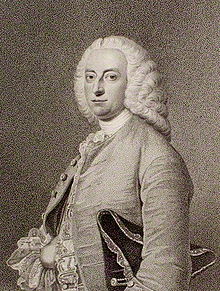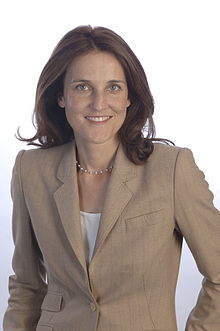|
Villiers familyVilliers (/ˈvɪlərz/ VIL-ərz) is an aristocratic family in the United Kingdom. Over time, various members of the Villiers family were made knights, baronets, and peers. Peerages held by the Villiers family include the dukedoms of Buckingham (1623–1687) and Cleveland (1670–1709), as well as the earldoms of Anglesey (1623–1661), Jersey (since 1697), and Clarendon (since 1776). Perhaps the most prominent members of the family were those who received the two dukedoms: George Villiers, 1st Duke of Buckingham (1592–1628) rose to fame and influence as favourite of King James I of England, while Barbara Villiers, Duchess of Cleveland (1640–1709) became a mistress of King Charles II of England, by whom she had five children. History  DescentThe Villiers family were settled at Brooksby, Leicestershire, from at least 1235.[1] In the early 13th century, the tenant of Brooksby, Gilbert de Seis, married a member of the Villiers family, a line of minor gentry of Norman descent.[2] The estate remained in Villiers hands for the next 500 years. At this time Brooksby consisted of the hall, the nearby Church of St Michael and All Angels, Brooksby, a small number of peasants' houses and a field system with common land.[3] In the 16th century, the family was represented by George Villiers († 1606), a minor gentleman who is said to have been a "prosperous sheep farmer".[4] He was High Sheriff of Leicestershire in 1591, and a Knight of the shire for the county from 1604 until his death. He was knighted in 1593.[1] Sir George Villiers was married twice, and left nine surviving children. Among the children from his first marriage were the eldest son, Sir William Villiers, 1st Baronet († 1629), who became the ancestor of the Villiers baronets; Edward († 1626), who became Master of the Mint and President of Munster; a daughter who married into the Boteler family; and another who married into the Washington family. Among the children from Sir George Villiers' second marriage to Mary (née Beaumont, † 1632) were George († 1628), the favourite of King James I of England who was eventually created Duke of Buckingham, and his sister Susan († 1652), who married the 1st Earl of Denbigh. According to Thomson,[5] Sir George Villiers is an ancestor of sixteen British prime ministers, from the 3rd Duke of Grafton to David Cameron. Rise to wealth and influenceIn August 1614, the then twenty-one-year-old George Villiers became the favourite of King James I of England, and remained in this position until the king's death in 1625. Under James's patronage, Villers advanced rapidly through the ranks of the nobility. In 1615 he was knighted as a Gentleman of the Bedchamber, and in 1616 elevated to the peerage as Baron Whaddon and Viscount Villiers. He was made Earl of Buckingham in 1617, then Marquess of Buckingham in 1618, and eventually Earl of Coventry and Duke of Buckingham in 1623.[6] Buckingham was the king's constant companion and closest advisor. Even after James I's death, Buckingham remained at the height of royal favour under Charles I, until he was assassinated in 1628. Buckingham was buried in Westminster Abbey, while his titles passed to his son George (1628–1687), upon whose death they became extinct. Continuing influenceAs a royal favourite during the reigns of James I and Charles I, Buckingham used his enormous political influence to prodigiously enrich his relatives and advance their social positions, which soured public opinion towards him.[7] Under his influence, several members of his immediate family were made knights, baronets and peers. His half-brother Edward († 1626) was knighted in 1616, while his mother was created Countess of Buckingham in her own right in 1618 and his eldest half-brother William († 1629) was created a baronet in 1619. Two of Buckingham's other brothers were similarly honoured when John († 1658) was created Baron Villiers of Stoke and Viscount Purbeck in 1619, and Christopher († 1630) was created Baron Villiers of Daventry and Earl of Anglesey in 1623. Sir Edward Villiers († 1626) married Barbara St John, daughter of Sir John St John († 1594) of Lydiard Tregoze, Wiltshire, by whom he had ten children.[1] Villiers' wife was the niece of Oliver St John, who was created Viscount Grandison in 1623. Grandison had no issue, so the Duke of Buckingham arranged for his half-brother's sons to inherit that title.[1] Sir Edward Villiers's eldest son, William († 1643), thus succeeded as second Viscount Grandison in 1630. He was the father of Barbara Villiers († 1709), one of the mistresses of King Charles II, by whom she had five children, and who was created Duchess of Cleveland in 1670. Sir Edward Villiers's second and third sons, John († c.1661) and George († 1699), succeeded as 3rd and 4th Viscounts Grandison, while the fourth son, Sir Edward Villiers († 1689), was father of Edward Villiers († 1711), who was created both Baron Villiers and Viscount Villiers in 1691 as well as Earl of Jersey in 1697. The 1st Earl of Jersey's sister, Elizabeth Villiers († 1733), was the presumed mistress of King William III of England from 1680 until 1695. Thomas Villiers († 1786), the second son of the 2nd Earl of Jersey, was created Baron Hyde and Earl of Clarendon in 1776. On the death of the 4th Viscount Grandison in 1699, the title passed to his grandson, the 5th Viscount. He was the son of Brigadier-General the Hon. Edward Villiers († 1693), eldest son of the 4th Viscount. In 1721 the 5th Viscount Grandison was created Earl Grandison. Upon his death in 1766, the earldom became extinct while the viscountcy passed to his second cousin William Villiers, 3rd Earl of Jersey, who became the 6th Viscount Grandison. In 1746 Elizabeth Mason, daughter of the 1st Earl Grandison, was created Viscountess Grandison, and in 1767 she was made Viscountess Villiers and Countess Grandison. All three titles became extinct on the death of the 2nd Earl Grandison in 1800. Theresa Villiers (born 1968), a British Conservative Party politician and former Secretary of State for Northern Ireland,[8][9] is a descendant of Edward Ernest Villiers (1806–1843), a son of George Villiers († 1827) and brother of George Villiers, 4th Earl of Clarendon.[10] Members of the familyEarls of Buckingham (1618)
Villiers baronets (1619)
Viscounts Purbeck (1619)
Viscounts Grandison (1623)
Earls of Anglesey (1623)
Dukes of Buckingham (1623)
Dukes of Cleveland (1670)
Earls of Jersey (1697)
Earls Grandison (1746)
Earls of Clarendon (1776)
Notable marriages
Other notable members
Members of the Order of the GarterSeveral members of the Villiers family have also been knights of the Order of the Garter. The following is a list is of all Villiers members of this order, across all branches of the family, along with their year of investiture.
ReferencesWikimedia Commons has media related to Villiers family.
|